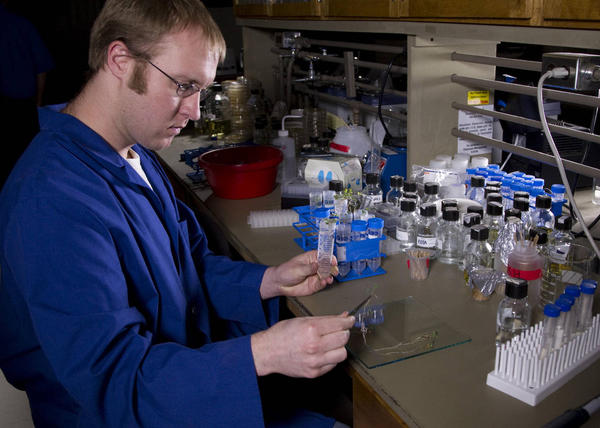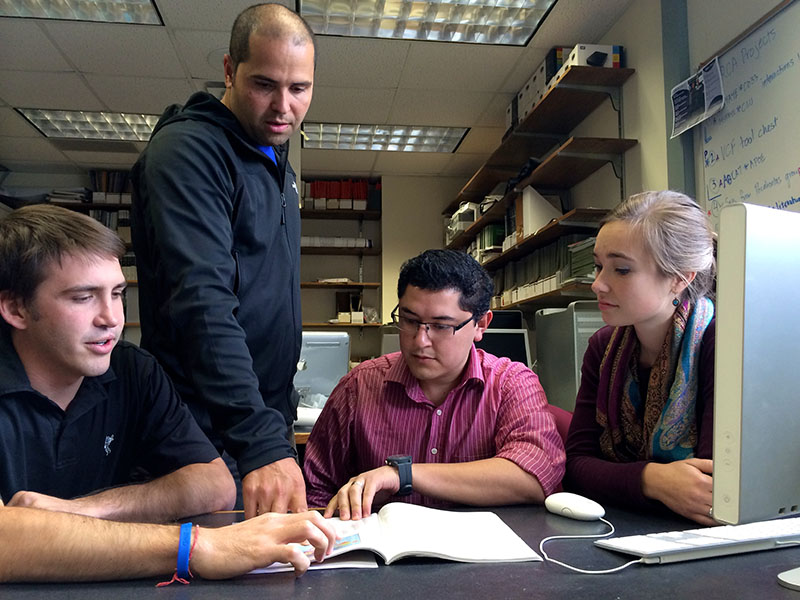The word science comes from the Latin “scientia,” meaning knowledge. A basic dictionary definition of the word “science” is “the intellectual and practical activity encompassing the systematic study of the structure and behavior of the physical and natural world through observation and experiment.” Thus, through observation and experimentation, a scientist is able to acquire knowledge to describe and explain natural phenomena to produce useful models of reality.
Knowledge of Raw Natural Gas Leads to Experimentation of New Energy Source
 Using their combined knowledge of raw natural gas, chemists from Brigham Young University (BYU) and the Scripps Research Institute, in the March 14 issue of Science magazine, identified a process that could be the answer to the current energy problem in the United States. Through observation and experimentation they have discovered a new way to turn raw natural gas into an upgraded liquid alcohol fuel, thus reducing the dependence on petroleum as a base for fuel.
Using their combined knowledge of raw natural gas, chemists from Brigham Young University (BYU) and the Scripps Research Institute, in the March 14 issue of Science magazine, identified a process that could be the answer to the current energy problem in the United States. Through observation and experimentation they have discovered a new way to turn raw natural gas into an upgraded liquid alcohol fuel, thus reducing the dependence on petroleum as a base for fuel.
The most unexpected breakthrough in the paper was that ordinary “main group” metals like thallium and lead can trigger the conversion of natural gas to liquid alcohol. The research teams found that natural gas to alcohol conversion occurs at 180 degrees Celsius – just a fraction of the heat needed with traditional “transition metal” catalysts (1400-1600 degrees Celsius). [1]
The researchers used different fields of science to understand how and why this process, which eliminates an entire step in the production of fuel, works. For example, BYU professor Daniel Ess used chemistry theory to understand how and why the process works at low temperatures under mild conditions. “Hardly anybody actually tries to do reactions on a genuine mixture that you would get from natural gas,” said Ess. “Turns out we can just directly use the mixture of what comes out of natural gas and convert all three of them together.” [1] Ess also commented that the potential benefits of the new process aren’t limited solely to the production of fuel, but other chemicals derived from natural gas such as methanol are important in manufacturing. No matter how the pie is sliced, the new process cuts down on energy usage.
Discovery of Rare Gene Variants Relate to Doubling Risks of Alzheimer’s disease
 In the realm of social science, a team of BYU researchers are continuing their studies of the genes that may be the cause of placing people at high risk of developing Alzheimer’s disease. Since 2009, BYU researchers have co-authored the publication of 22 new Alzheimer’s risk gene studies, and recently they have discovered gene variations that could possibly double the risk of developing Alzheimer’s later in life.
In the realm of social science, a team of BYU researchers are continuing their studies of the genes that may be the cause of placing people at high risk of developing Alzheimer’s disease. Since 2009, BYU researchers have co-authored the publication of 22 new Alzheimer’s risk gene studies, and recently they have discovered gene variations that could possibly double the risk of developing Alzheimer’s later in life.
The research is led by Washington University School of Medicine at St. Louis, Missouri. It was published online in the scientific journal, Nature, on 11 December 2013. The authors of the study are Biology professors John Kauwe and Perry Ridge, and BYU post-baccalaureate Maegan Leary. Cameron Schmutz, an undergraduate, is the co-author of the study.
Using a clever approach for identifying rare mutations, the investigators focused on families with several members who had Alzheimer’s. The team sequenced genes from several individuals in 14 families, some of which had Alzheimer’s and some who did not.
Comparing DNA from affected people in a family to those in the same family without the disorder, the team eventually identified variations in a gene (PLD3) that showed up in affected family members. Researchers then studied another 11,000 people with and without the disease and found PLD3 gene variants doubled the risk for Alzheimer’s disease. [2]
Alison Goate, a co-author from Washington University, stated that by studying gene variants within families, the team is able to narrow down the number of variants that may actually be the cause of the disorder, whereas, if they had tested unrelated individuals, the statistical analysis would have been skewed and they would not have been able to identify these rare variants.
To complete the study, “researchers used a process called whole exome sequencing to identify mutations in a gene never before linked to Alzheimer’s disease then used other technologies to sequence those variants in additional samples.” [2] Much of that work took place on the BYU campus where undergraduate, Cameron Schmutz, tested and analyzed over 5,000 DNA samples.
“This progress has been very rapid and bodes well for the future fight against this disease,” said Dr. Kauwe. “While new genes do not immediately mean new cures, they provide the foundation of knowledge upon which effective prevention and cures can be built. Each new gene provides us with new insights into therapeutic approaches that might work. Scientists around the world are excited to see these new discoveries and try to develop better drugs using that information.” [2]
There are many different areas of science that are open for exploration. As scientists continue to apply their knowledge and scientific methods in investigating matters of science, whether in the natural or social realm, more and more breakthroughs will be made through their deductive observations and reasoning.
Additional Resource:
New Infrared Technique aims to Remotely Detect Dangerous Materials
About Keith L. Brown
Keith L. Brown is a convert to The Church of Jesus Christ of Latter-day Saints, having been born and raised Baptist. He was studying to be a Baptist minister at the time of his conversion to the LDS faith. He was baptized on 10 March 1998 in Reykjavik, Iceland while serving on active duty in the United States Navy in Keflavic, Iceland. He currently serves as the First Assistant to the High Priest Group for the Annapolis, Maryland Ward. He is a 30-year honorably retired United States Navy Veteran.



